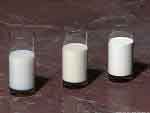A new UC San Diego computer graphics model capable of generating realistic images of milk based on its fat and protein content will likely push the field of computer graphics into the realms of diagnostic medicine and food safety.
'We have harnessed the maths and physics necessary to generate realistic images of a wide range of natural materials based on what they are made of. With our approach, computer graphics can contribute to a handful of pressing problems,' said Henrik Wann Jensen, a UC San Diego computer science professor and Academy Award winning computer graphics researcher.
Jensen created the model with two colleagues from the Technical University of Denmark - Niels Jørgen Christensen, an associate professor, and Jeppe Revall Frisvad, a PhD student.
On August 8, their research was presented at the Association for Computing Machinery’s SIGGRAPH conference, the premier annual conference for the graphics and interactive techniques community.
'If you tell the new computer graphics model how much fat and protein you want in your milk, the model will spit out the information you need to create a life-like milk image by determining how light will interact with your specified ratio of milk fats and proteins. Similarly, if you specify the concentration of algae and different minerals in a sample of ocean water, the same theoretical model will render the colour of the water,' Jensen said.
In addition to creating images based on what a material is made of, the researchers used the milk example to show that the new model can work backwards and determine how much fat and protein a sample of milk contains, based on just a digital picture of the milk.
'Putting the model in reverse, grocery stores could identify spoiled meats, contaminants or other food safety issues – if a particular food problem consistently and detectably changed the light scattering properties of the food,' said Jensen.
'If you are trying to generate realistic computer graphics, it is intuitive to specify what the material is made of, like the amount of fat and protein in the milk. In the past, we had to do a lot of observing and measuring to determine how the milk would scatter and absorb light,' said Jensen. '“With our theoretical approach, a much wider range of people will be able to play a role in creating realistic images of natural materials.'
'We can visualise what specific particles – like milk fats or proteins – look like on their own. We can also visualise what a medium would look like if one particle type were missing. Having knowledge about the visual effect caused by each type of particle is incredibly valuable in many different contexts,' added Jeppe Revall Frisvad, the PhD student from the Technical University of Denmark.

Rendered images of the components in milk as well as mixed concentrations. From left to right, the glasses contain: Water, water and vitamin B2, water and protein, water and fat, skimmed milk, regular milk, and whole milk




Swiss geoengineering start-up targets methane removal
No mention whatsoever about the effect of increased methane levels/iron chloride in the ocean on the pH and chemical properties of the ocean - are we...